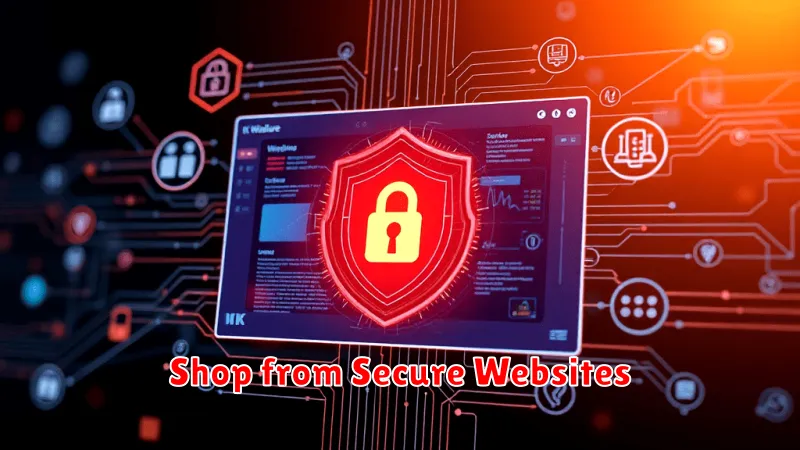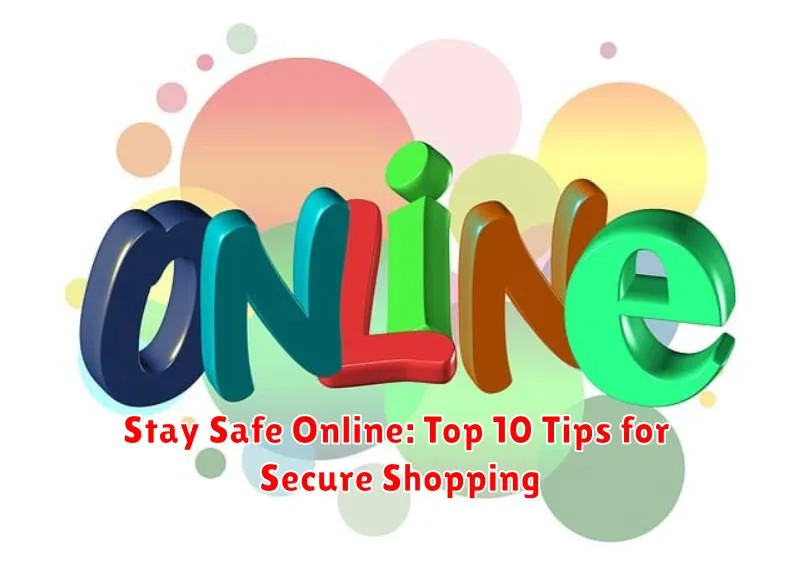In today’s digital age, online shopping offers unparalleled convenience, allowing us to purchase virtually anything with a few clicks. However, this convenience comes with inherent risks. Safe and secure online shopping practices are crucial to protect your personal and financial information from cybercriminals. This article provides top 10 tips for secure online shopping to ensure a safe and worry-free experience. Learn how to identify secure websites, protect your passwords, and avoid common online shopping scams. By following these guidelines, you can confidently enjoy the benefits of online shopping while mitigating potential threats.
Navigating the vast landscape of e-commerce requires vigilance and awareness. From secure payment methods to understanding privacy policies, this guide covers essential aspects of safe online shopping. Learn how to recognize phishing attempts, verify seller legitimacy, and protect yourself from identity theft. With these top 10 tips, you’ll be equipped to make informed decisions and safeguard your information while taking advantage of the convenience and variety offered by online shopping.
Secure Your Accounts with Strong Passwords
Strong passwords are the first line of defense against unauthorized access to your online accounts. A weak password can be easily guessed or cracked by hackers, putting your personal and financial information at risk.
Create passwords that are at least 12 characters long and include a mix of uppercase and lowercase letters, numbers, and symbols. Avoid using easily guessable information like your name, birthday, or pet’s name. Consider using a password manager to generate and securely store complex passwords.
Never reuse passwords across different accounts. If one account is compromised, all accounts using the same password become vulnerable. Regularly update your passwords, especially for crucial accounts like email and online banking.
Enable two-factor authentication (2FA) whenever possible. This adds an extra layer of security by requiring a second verification method, such as a code sent to your phone, in addition to your password.
Beware of Phishing Scams
Phishing scams are designed to trick you into revealing sensitive information such as your usernames, passwords, and credit card details. Be wary of emails, text messages, or pop-up windows that appear to be from legitimate businesses but ask for personal information.
Never click on links within suspicious emails or messages. Instead, navigate directly to the official website of the company in question. Look for telltale signs of phishing, such as poor grammar, misspellings, generic greetings, and urgent requests for action.
Verify the sender’s address carefully before responding to any requests for information. If anything seems suspicious or too good to be true, it probably is. Report suspected phishing attempts to the Anti-Phishing Working Group or the Federal Trade Commission.
Shop from Secure Websites

When shopping online, ensure you’re on a secure website. Look for “https” in the address bar. The “s” stands for secure, indicating that the website uses encryption to protect your information. A padlock icon next to the address bar is another visual indicator of a secure connection.
Be wary of websites with unusual URLs or misspellings. These could be fake websites designed to steal your information. Stick to reputable online retailers that you know and trust.
Research the website before making a purchase. Look for customer reviews and ratings to get an idea of the website’s legitimacy and customer service. If you see numerous negative reviews or reports of scams, it’s best to avoid that website.
Use Secure Payment Methods
When shopping online, prioritize secure payment methods that offer buyer protection. Credit cards are generally a safer option than debit cards, as they provide better fraud protection and liability limits. If fraudulent charges occur, you are not directly liable for the funds lost.
Consider using digital wallets or payment platforms like PayPal or Apple Pay. These services add an extra layer of security by tokenizing your card information, meaning merchants never receive your actual card number. This reduces the risk of your card details being compromised in a data breach.
Avoid using wire transfers, money orders, or prepaid gift cards for online purchases, especially from unfamiliar vendors. These methods offer little to no recourse if something goes wrong. They are often the preferred payment method for scammers because they are difficult to trace.
Check Privacy Policies
Before providing any personal information or making a purchase, carefully review the website’s privacy policy. This policy outlines how the company collects, uses, and protects your data.
Look for key information, such as what data they collect (e.g., name, address, payment information), how they use it (e.g., for processing orders, marketing), and whether they share it with third parties. A transparent and comprehensive privacy policy is a good sign of a reputable website.
Pay close attention to the sections about data sharing and tracking. Understand how your data might be used for advertising or other purposes. If a website’s privacy policy is vague, difficult to understand, or raises concerns, consider shopping elsewhere.
Understanding a website’s privacy practices empowers you to make informed decisions about sharing your information and protects your online privacy.
Avoid Public Wi-Fi for Online Shopping
Public Wi-Fi hotspots are convenient, but they often lack strong security measures. This makes them a prime target for hackers who could intercept your data, including login credentials and credit card information. When shopping online, always use a secure network.
If you must use public Wi-Fi, consider using a virtual private network (VPN). A VPN encrypts your internet traffic, creating a secure connection even on a public network. This adds a layer of protection against potential threats.
Avoid entering sensitive information like credit card details or bank account numbers while connected to public Wi-Fi, even with a VPN. The risk, although minimized, is still present.
Keep Your Software Updated
Outdated software is a significant vulnerability when shopping online. Cybercriminals frequently exploit known weaknesses in older operating systems, web browsers, and plugins. Keeping your software up to date is crucial in patching these security holes and protecting your information.
Enable automatic updates whenever possible. This ensures you receive the latest security patches as soon as they are released. For software that doesn’t offer automatic updates, schedule regular checks for new versions and install them promptly. This includes not only your operating system but also applications like your web browser, PDF reader, and any software used for financial transactions.
Pay particular attention to your antivirus and anti-malware software. These programs are your first line of defense against malicious software that can steal your data. Ensure these are updated regularly to stay effective against evolving threats.
Monitor Your Bank Statements Regularly
Regularly reviewing your bank and credit card statements is a crucial step in protecting yourself from online shopping fraud. Frequent monitoring allows you to quickly identify any unauthorized transactions or suspicious activity.
Check your statements at least once a week, or even more frequently if you shop online often. Look for any charges you don’t recognize, even small ones. Small, unauthorized charges can sometimes be a test by fraudsters to see if an account is active. Catching these early can prevent larger fraudulent transactions later.
Immediately report any discrepancies to your bank or credit card company. They can investigate the issue and take necessary steps, such as reversing fraudulent charges or issuing a new card.
Consider using online banking or mobile apps that provide real-time transaction alerts. These alerts can notify you of purchases as they happen, allowing you to quickly identify and address any unauthorized activity.
Be Cautious of Deals That Seem Too Good to Be True
If a deal seems unbelievably good, it probably is. Unrealistic discounts are a major red flag for online shopping scams. Scammers often use incredibly low prices to lure unsuspecting shoppers into their traps. While everyone loves a bargain, extreme markdowns should raise suspicion.
Take the time to research the average price for the item you are interested in. If the offered price deviates significantly from the norm, proceed with extreme caution. Consider why the seller would be offering such a deep discount. It is possible they are selling counterfeit goods, or worse, attempting to steal your financial information.
Compare prices across multiple reputable retailers to get a sense of the market value. If the deal still seems too good to be true after your research, it’s best to err on the side of caution and avoid the purchase.
Report Suspicious Activity

If you encounter any suspicious activity while shopping online, it’s crucial to report it promptly. This helps protect you and others from potential fraud. Suspicious activity could include unauthorized charges on your credit card, unfamiliar account login attempts, or phishing emails disguised as legitimate retailers.
Who to Report To:
- Your Bank or Credit Card Company: Immediately contact your financial institution if you notice any unauthorized transactions. They can block your card and investigate the activity.
- The Retailer: Report suspicious emails, website issues, or questionable transactions directly to the online retailer’s customer service department.
- Law Enforcement: For significant financial losses or suspected identity theft, filing a police report is essential. This creates an official record of the incident.
- The Federal Trade Commission (FTC): You can report online shopping scams and fraud to the FTC online or by phone.
By being vigilant and reporting any suspicious activity, you contribute to a safer online shopping environment for everyone.

